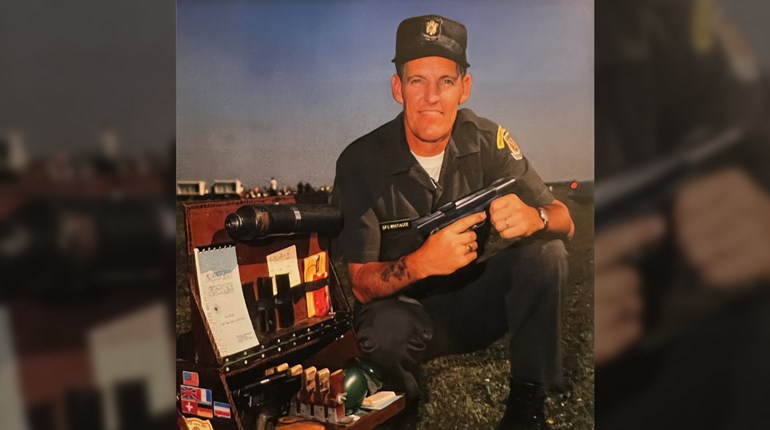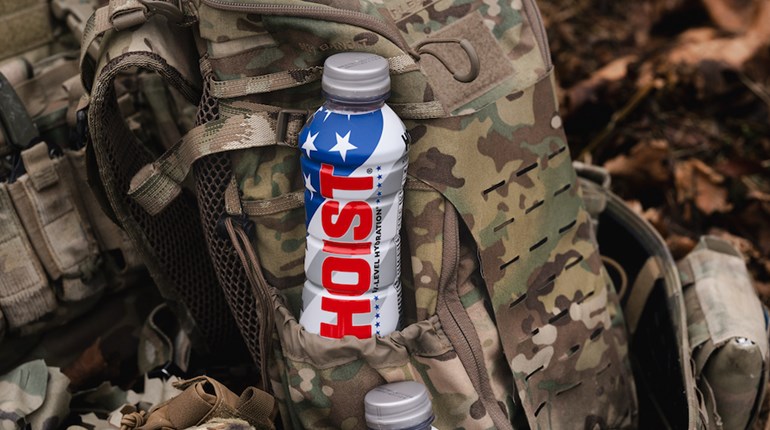
I recently received an invitation to join the U.S. Army at Fort Bragg, NC, home of the one of the most covert, respected and focused fighting units in the world—the Special Forces, also known as the Green Berets. This elite group maintains a grueling physical and mental entry curriculum that results in a 75-percent dropout rate. But those who qualify become members of a close-knit combat team whose theaters of action encompass the globe. Right now, of course, much of its focus is in the Middle East. The mission, in the words of one Special Forces major, is "…to ensure that people who should be dead are dead, and that people who should be rescued are rescued." To accomplish this, the Special Forces is equipped with some of the most advanced weapons in modern warfare and is trained to use them in the most effective manner possible.
The last time I received an invitation from the Army, it was decades ago and involved an all-expense paid trip that included clothing, meals and a cadre of personal trainers for what turned out to be Boot Camp. Then came Advanced Infantry Training and finally Officer's Candidate School. But this time I was being invited as a gun writer/photographer for a hands-on view of the personal combat weapons used by the Special Forces. Naturally, with my wife's tongue-in-cheek admonition not to sign anything, I eagerly accepted.
In order to protect the identities of our men in uniform, many of whom are engaged in covert activities, I was asked not to photograph full facial views of Special Forces soldiers, nor to show their name tags. I also made a personal decision not to use any individual's name in recorded interviews, as I know from experience that sometimes even the most innocent comments may not sit well with one's superiors. Of course, anything that was of a sensitive nature was off limits, unless it was already a matter of public record. But just to be sure, I submitted a list beforehand of the weapons I wanted to photograph and shoot.
So here are the guns of the Special Forces. While this is in no way an all-encompassing list (many weapons were classified or simply not available), it represents an awesome display of firepower designed to protect America's freedom in the hands of one of our most skilled and effective fighting units.
M4 CarbineSpecial Forces is issued the M4 carbine, manufactured exclusively for the U.S. military by Colt Defense. The M4 is chambered for the same 5.56 NATO cartridge as the M16 and uses the same M9 bayonet, although the M4 is fitted with a four-position, telescoping stock and has a shorter, 14.5-inch barrel. Weighing 6.9 pounds with a fully loaded, 30-round magazine, the M4 is capable of full or semi-automatic fire. Normally it also has a three-round burst capacity, but the Special Forces use the M4A1, which has full and semi-automatic capacities without a three-shot burst setting.
The M4 can be fitted with a number of accessories, including laser and night-vision sights, the RIS vertical forestock handgrip and a suppressor. The carbine can also be equipped with an M203 grenade launcher—the same version used with the M16. This 12-inch tube mounts underneath the barrel and fires a single, 40 mm grenade via a separate trigger in front of the magazine, which doubles as a makeshift pistol grip when firing grenades. When outfitted with the 203, the M4 uses a separate set of differently calibrated sights. Standard grenade types are high explosive, illumination, buckshot, smoke, direct fire, High Explosive Dual Purpose, CS gas and inert blue-tipped training grenades.
I found the M4A1 to be extremely accurate and effective, due to its natural pointability and mild recoil. My first experience with this specialized carbine was not at a target range, but in a simulated attack situation at Camp Mackall, just outside Fort Bragg, where the Special Forces conduct much of its training.
Here, in a glass-windowed room at the Virtual Live Fire Training Facility, a group of observers and I watched a team of Special Forces soldiers armed with M4A1 carbines clear a room of terrorists with the synchronized skill and coordination of a Bruce Willis action movie. The room was actually made up of computerized rearview screens that projected realistic images of terrorists—when they got hit, blood splattered on the walls. Future plans call for incorporating holograms, which will create an even more realistic training scenario because participants could be surrounded by terrorists.
Then one of the instructors asked for a volunteer to duplicate what we had just seen, using one of the M4A1 carbines. Although the old Army mantra is "Never volunteer for anything," I couldn't resist. Under the supervision of a Special Forces instructor, I placed the rifle on semi-automatic, as there were also "friendlies" in the room and I knew I would be singling out targets. Then, using the laser sight, I surprised myself and my instructor by scoring 20 hits out of 20 shots. Of course, I had an advantage; no one was shooting back at me.
Later at the outdoor live-fire range, using an M4A1 with an Aimpoint sight, I fired three-shot bursts and scored solid hits on a 50-yard silhouette target, taking out a small center section in the chest area. "It's my favorite weapon," said a lieutenant colonel who had served multiple tours in Iraq. But when I spoke with some other soldiers, I got a different story.
It seems the M4 shares another similarity with the M16 besides some design features and parts. It also has a propensity to jam when fouled. This has become especially prevalent in the fine-dust environments of Iraq and Afghanistan. Even with the dustcover closed and a magazine in place, blowing debris penetrates the action and causes malfunctions. In addition, the M4 gas-operating system blows carbon fouling into the receiver, resulting in failures to feed and eject.
This is not an easy situation to remedy mechanically or logistically. In order for Colt to make changes to the M4, a governmental directive has to be issued, and to my knowledge, none has been forthcoming. The obvious solution is to keep the rifle perpetually clean—a routine practiced regularly in camp, but not always possible in the field. As a result, many soldiers carry a cleaning rod attached to their carbines to poke out jammed rounds during combat; an awkward and potentially dangerous endeavor.
That's why the Aug. 7, 2007, issue of the Army Times reported new weapons were being discussed as possible replacements. One of the most likely candidates is the Heckler & Koch 416 Carbine, or HK416D—the "D" standing for Delta Force (officially, the 1st Special Forces Operational Detachment-Delta), the clandestine counter-terrorism group within the Special Forces that worked with H&K developing this weapon and who, along with the U.S. Naval Special Warfare Development Group, are now using it. There's also a civilian version, the MR556A1, now available.
Externally the HK416D looks much like an M4, but internally it uses a short-stroke gas piston system that does away with—or dramatically reduces—the M4's failure to eject or extract. In addition, the United States Special Operations Command (USSOCOM) contracted with FN Herstal to design a new Special Operations Combat Assault Rifle, which has been adopted in piecemeal fashion. But with the Army already scheduled to purchase an additional 100,000 M4s , it remains to be seen if any replacements will make it to the Special Forces anytime soon. Which means the two weapons sergeants in each 12-man Special Forces team will continue to be busy.
Beretta M9The secondary weapon for the Special Forces is the Beretta M9, the military version of the civilian Beretta M92FS. Basically, aside from a few slide and receiver markings, the guns are identical.
In the regular Army, the M9 is primarily issued to machine gun and tank crews, squad leaders and various support personnel. But I saw a lot of Bianchi M12 Ambidextrous Holsters on the hips of Special Forces soldiers, who often refer to the M9 as simply a "9 mil." In combat, they are often issued with three or four 15-round magazines.
"I usually don't carry it when going out with a larger element," one Special Forces sergeant told me, "but when in a small team, it's advisable to carry an M9, just in case something does go down on your M4."
There has been a great deal written about the pros and cons of the M9, and rather than rehash the arguments here, I would just note that the most reoccurring criticisms are its over-penetration and lack of stopping power."I think we should go back to the 1911," said one staff sergeant just back from Iraq. "It's got greater hitting power and greater stopping power. It's hard to stop a guy running at you when he's all juiced up on heroin and you're shooting at him with a 9 mm."
But this, in my opinion, is more a criticism of the NATO M882 FMJ cartridge our troops are required to use, rather than of the firearm itself. As for reliability, at the range at Camp Mackall, I went through four, 15-round magazines with no malfunctions of any kind. In addition, I have fired thousands of rounds through my own M9 with nary a jam.
Glock 19The Glock 19 is a slightly condensed version of the Glock 17. It is issued in limited numbers to some civilians assigned to the Special Forces, as well as to a few Special Forces officers.
As with the Beretta M9, much has been written about the Glock, and there is little to be gained by venturing over familiar ground, other than to note that the Glock 19 fires the same M882 cartridge as the M9, in a double-stack, 15-round magazine (compared to the Glock 17's standard 17-round and extended 19-round magazine capacities). I should note that even when rapid-firing the Glock 19, I had absolutely no malfunctions with NATO ammunition.
M249 SAWThe M249 Squad Automatic Weapon, or SAW, as it is commonly called, has been in use since the 1980s and has replaced the M60 machine gun of Vietnam fame. A rather bulky weapon, the SAW weighs 16.5 pounds and utilizes a bipod. It fires the same 5.56 NATO round as the M4 and can be carried by one squad member trained in its use.
And lest you think 16.5 pounds is a bit much to be lugging around in the field, I should point out that the Special Forces troops routinely go into battle wearing up to 90 pounds of equipment, including body armor, ammo and water.
A gas-operated, air-cooled weapon that fires from the open-bolt position, the SAW used by Special Forces (and other U.S. Army units) is made by FNH USA, the American subsidiary of FN Herstal in Belgium. It is a fully automatic rifle—there is no semi-auto setting—and fires at a rate of 750 rounds per minute, which are fed from a linked belt. In an emergency, M4 magazines can be loaded from the side. The SAW can also be mounted on Humvees and similar vehicles.
Unfortunately, the SAW shares another commonality with the M4 besides chambering the same cartridge: a propensity to jam. At an indoor simulated battlefield range using a laser-equipped SAW, I experienced what many soldiers in Iraq and Afghanistan have encountered, only in my case, my weapon would jam every five to ten rounds. If this had been an actual firefight, my assistant gunner would have been busy.
It turns out that the weakest link in my SAW was exactly that—the links in the cartridge belt kept breaking. But even when magazines are substituted, extractor problems occur, although much of this can be attributed to the dirt and dust of desert warfare.
Still, one Special Forces armorer just back from Kuwait told me enthusiastically, "My favorite weapon is the 249. I'd pass up the M16 or the M4 for that weapon, just for what it can do—its rate of fire is phenomenal."
Mark 12 Mod O SPRThe Special Purpose Rifle (SPR) is a semi-automatic, sniper-enhanced version of the M16, with an 18-inch, free-floating stainless steel barrel and an effective range of 600 yards. It uses either 20- or 30-round NATO-approved STANAG (Standardized Agreement) magazines. Even though the SPR is chambered for the 5.56 NATO round, the load is slightly different than the 62-grain M885 used in the M4. The SPR fires the more accurate Mark 262 Open Tip Match (OTM) load made by Black Hills Ammunition.
The Mark 12 SPR originally started out as a Colt-made M16 receiver to which a variety of attachments could be fitted, but it has evolved to a more or less standardized Mod 0 used by the Special Forces today. The Special Forces Mod 0 features different front and rear sights and a different free-floating handguard. True to its special purpose nomenclature, the MK 12 can be fitted with a plethora of attachments for a variety of missions, including fixed or telescoping stocks, bipods, various scopes, infrared and laser sights, muzzle brakes and suppressors.
M24A2 SWSYou probably know this rifle by its more familiar name, the Remington 700. However, unlike the deer rifle you may have in your gun rack, the M24 Sniper Weapons System (SWS) includes a detachable Leupold 10x42 mm Ultra M3A scope and an adjustable stock. For the Special Forces, the M24A2 is outfitted with a detachable 10-round magazine and Remington MARS (Modular Accessory Rail System) Picatinny rail. The barrel is modified for a suppressor.
The rifle is chambered for 7.62 NATO or .300 Win. Mag. A longer-range version, the M24A3, is chambered for the Finnish-designed .338 Lapua Mag., which has the ability to pierce body armor at 1,000 yards.
A new sniper rifle, the M110 SASS (Semi-Automatic Sniper System) is supplementing M24 after extensive field-testing in Iraq and Afghanistan. It is a variant of the SR25 (Stoner Rifle-25), which, with modifications, is known as the MK11 currently used by the Navy.
Another rifle, the XM2010, is currently being rolled-out to supplement or replace the M24. This .300 Win. Mag. rifle is a near-complete redesign of the M24 and promises to add about 400 meters to the platform's effective range.
Barrett M107 .50-Caliber Anti-Material Sniper RifleMuch has been written about Ronnie Barrett's behemoth, long-range, anti-material sniper rifle, but to see it perform in the skilled hands of a Special Forces sniper and his spotter makes one wonder why the jihadists don't just give up. Even with ear muffs, I heard the thunderous roar, felt the earth shake, and saw loose gravel jump 2 inches off the ground when a Special Forces sniper touched off one of the 10 .50-caliber rounds in his magazine. A split-second later an automobile parked on the 1,000-yard line exploded.The Barrett M107—an improved version of the M82—weighs 31 pounds, sports a much-needed bipod, side-venting muzzle brake and retracting barrel that helps absorb recoil and most likely prevents broken shoulder blades. The .50 BMG cartridge's 600-grain bullet leaves the M107's 29-inch barrel at 2,850 fps and can strike a target more than a mile away with enough force to…well, blow up a car. Concrete walls provide no barrier between the muzzle of this semi-automatic mini-cannon and its target.
Recently, Barrett introduced the M107A1, a version of the big .50 that manages to be structurally stronger yet weigh 4 pounds less than the original.
MP5A3 Submachine GunWhile waiting for my flight home, I struck up a conversation with a young infantryman just back from Iraq. When I told him my favorite weapon was the MP5, his eyes lit up.
"Wow," he exclaimed, "you got to shoot the MP5? We never get to see those. They're only for Special Forces."
And Navy SEALs as well. Made by Heckler & Koch, this compact 5.5-pound 9 mm sub-machine gun produced almost no recoil. Unbelievably fun to shoot with a cycle rate of 800 rounds per minute, its 15- and 30-round detachable magazines emptied all too quickly. A telescoping stock and 8-inch barrel made the MP5 easy to handle, especially the MP5SD variant I used, which featured an integrated suppressor and a lighter bolt for faster cycling. The selector switch can be set for safe, semi-automatic and fully automatic, with special adaptor trigger groups for 2- and 3-round bursts.
"This is a sexy weapon," said a first sergeant at the range, "the one you always see with the Navy SEALs in the movies because everybody wants to look cool."
M240 BThis light machine gun, usually referred to as the "240 Bravo," is one of the most reliable in service. In spite of its rather ugly, humped-back appearance and hefty 27.5 pounds, it is highly regarded by those who have used it in combat. Belt-fed and chambered for the 7.62 NATO round, it is crew-served, but deserves mention.
M32And finally we come to the MGL-14 (Multiple Grenade Launcher), which has recently been updated to the M32. Made by Milkor USA, this weapon looks like an oversized revolver with a spring-wound cylinder. But instead of cartridges, each of the six chambers holds a 40 mm grenade—including the Hellhound, which, upon impact, explodes with a disintegrating mass of molten metal and deadly fragmentation.
The M32 is capable of firing two rounds a second, with devastating results that have justifiably been called "The Six Pack Attack." Although not officially used by the Special Forces, it is under evaluation and has already been adopted by the U.S. Marines.




































